
Checking the location and structure of the cervix throughout your menstrual cycle is certainly something that requires practice. Cervical changes are highly individual, and you will need some time to get used to monitoring your cervix to fully understand where in your cycle you are. Checking cervical positioning works best if you do it in combination with other methods to monitor your fertility. Charting, using ovulation tests, and checking your cervical mucus, all provide accurate information if used correctly.
Now for the details of cervical checking itself. First of all, you need to make sure that your hands are absolutely clean before you do it, to prevent infections. Checking your cervix is the easiest if you sit on the toilet or squat in the bath. With time, you will find out what the best position is for you. So, how to recognize ovulation? What is the difference between cervical location during your menstruation, in the first few weeks, during ovulation, and in the luteal phase? At the beginning of your cycle (during your period and sometime after that), your cervical will typically be low and hard. It will be opened slightly to assist the expulsion of menstrual flow. As you approach ovulation, your cervix will start to feel more soft and squishy, and be near the top of your vagina. Sometimes, you will not even be able to feel your cervix during ovulation. During the luteal phase of your cycle, the cervix will once again be hard and firm.















Your thoughts on this
Loading...